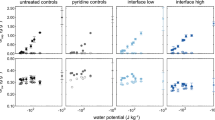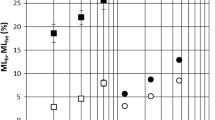Abstract
This paper evaluates the effects of acetylation level and experimental method on the observed fiber saturation point (FSP) of loblolly pine (Pinus taeda) wood measured using differential scanning calorimetry. To achieve this goal, 1-mm-thick latewood samples were tested over a wide range of equilibrium moisture content (EMC). In this work, the FSP was defined as the non-freezable portion of water of the samples. Two experimental methods were used: the extrapolation of the melting enthalpy to zero and the direct calculation of the non-freezable water amount. For both methods, the FSP decreased with increasing acetylation, varying from about 27% reduced EMC (EMCR) for control to about 9% EMCR for the highest level of acetylation. For unmodified samples, the measured FSP was higher with faster scan rates. Moreover, under a specific range of EMCR, freezing curves revealed the occurrence of two water phase transitions for samples at the highest level of acetylation. Based on previous studies and in present findings, there is strong evidence that the lower temperature freezing peak may result from the homogenous nucleation of water, which is physically separated from water that freezes heterogeneously.





Similar content being viewed by others
References
Almeida G, Hernández RE (2006a) Changes in physical properties of tropical and temperate hardwoods below and above the fiber saturation point. Wood Sci Technol 40:599–613
Almeida G, Hernández RE (2006b) Changes in physical properties of yellow birch below and above the fiber saturation point. Wood Fiber Sci 38:74–83
Almeida G, Brito JO, Perré P (2009) Changes in wood-water relationship due to heat treatment assessed on micro-samples of three Eucalyptus species. Holzforschung 63:80–88
Babiak M, Kúdela J (1995) A contribution to the definition of the fiber saturation point. Wood Sci Technol 29:217–226
Barkas WW (1935) Fibre saturation point of wood. Nature 133(3414):545
Berry SL, Roderick ML (2005) Plant–water relations and the fibre saturation point. New Phytol 168:25–37
Dos Santos DVB, de Moura LF, Brito JO (2014) Effect of heat treatment on color, weight loss, specific gravity and equilibrium moisture content of two low market valued tropical woods. Wood Res Slovak 59:253–264
Engelund ET, Thygesen LG, Svensson S, Hill CAS (2013) A critical discussion of the physics of wood–water interactions. Wood Sci Technol 47:141–161
Esteves B, Pereira HM (2009) Wood modification by heat treatment: a review. BioResources 4:370–404
Feist WC, Tarkow H (1967) A new procedure for measuring fiber saturation points. Forest Prod J 17:65–68
FPL (2010) Wood handbook—wood as an engineering material. General technical report FPL-GTR-190. U.S. Department of Agriculture, Forest Service, Forest Products Laboratory, Madison, WI
Fukazawa K, Revol JF, Jurasek L, Goring DAI (1982) Relationship between ball milling and the susceptibility of wood to digestion by cellulase. Wood Sci Technol 16:279–285
Hernández RE (2007a) Moisture sorption properties of hardwoods as affected by extraneous substances, wood density, and interlocked grain. Wood Fiber Sci 39:132–145
Hernández RE (2007b) Effects of extraneous substances, wood density and interlocked grain on fiber saturation point of hardwoods. Wood Mater Sci Eng 2:45–53
Hernández RE, Bizoň M (1994) Changes in shrinkage and tangential compression strength of sugar maple below and above the fiber saturation point. Wood Fiber Sci 26:360–369
Hernández RE, Cáceres CB (2010) Magnetic resonance microimaging of liquid water distribution in sugar maple wood below fiber saturation point. Wood Fiber Sci 42:259–272
Hernández RE, Pontin M (2006) Shrinkage of three tropical hardwoods below and above the fiber saturation point. Wood Fiber Sci 38:474–483
Hill CAS (2006) Wood modification: chemical, thermal and other processes. Wiley, Chichester
Hill CAS (2008) The reduction in the fibre saturation point of wood due to chemical modification using anhydride reagents: a reappraisal. Holzforschung 62:423–428
Hill CAS, Forster SC, Farahani MRM, Hale MDC, Ormondroyd GA, Williams GR (2005) An investigation of cell wall micropore blocking as a possible mechanism for the decay resistance of anhydride modified wood. Int Biodeterior Biodegrad 55:69–76
Himmel S, Mai C (2015) Effects of acetylation and formalization on the dynamic water vapor sorption behavior of wood. Holzforschung 69:633–643
Hosseinpourpia R, Mai C (2015) Mode of action of brown rot decay resistance of acetylated wood: resistance to Fenton’s reagent. Wood Sci Technol 50:413–426
Menon RS, MacKay AL, Hailey JRT, Bloom M, Burgess AE, Swanson JS (1987) An NMR determination of the physiological water distribution in wood during drying. J Appl Polym Sci 33:1141–1155
Mykhailyk VA, Snezhkin YF, Dmitrenko NV (2015) Investigation of the state of water in energy trees in the process of drying by differential scanning calorimetry. J Eng Thermophys 88:1093–1099
Nakamura K, Hatakeyama T, Hatakeyama H (1981) Studies on bound water of cellulose by differential scanning calorimetry. Text Res J 51:607–613
Nearn WT (1955) Effect of water soluble extractives on the volumetric shrinkage and equilibrium moisture content of eleven tropical and domestic woods. Pennsylvania State University, College of Agriculture, Bulletin 598, State College
Nelson RA (1977) The determination of moisture transitions in cellulosic materials using differential scanning calorimetry. J Appl Polym Sci 21:645–654
Olek W, Majka J, Czajkowski Ł (2013) Sorption isotherms of thermally modified wood. Holzforschung 67:183–191
Papadopoulos AN (2010) Chemical modification of solid wood and wood raw material for composites production with linear chain carboxylic acid anhydrides: a brief review. BioResources 5:499–506
Papadopoulos AN, Hill CAS (2002) The biological effectiveness of wood modified with linear chain carboxylic acid anhydrides against Coniophora puteana. Holz Roh Werkst 60:329–332
Papadopoulos AN, Hill CAS (2003) The sorption of water vapour by anhydride modified softwood. Wood Sci Technol 37:221–231
Papadopoulos AN, Avramidis S, Elustondo D (2005) The sorption of water vapour by chemically modified softwood: analysis using various sorption models. Wood Sci Technol 39:99–112
Papadopoulos AN, Avtzis D, Avtzis N (2008a) The biological effectiveness of wood modified with linear chain carboxylic acid anhydrides against the subterranean termites Reticulitermes flavipes. Holz Roh Werkst 66:249–252
Papadopoulos AN, Duquesnoy P, Cragg SM, Pitman AJ (2008b) The resistance of wood modified with linear chain carboxylic acid anhydrides to attack by the marine wood borer Limnoria quadripunctata Hothius. Int Biodeterior Biodegrad 61:199–202
Passarini L, Hernández RE (2016) Effect of the desorption rate on the dimensional changes of Eucalyptus saligna wood. Wood Sci Technol 50:941–951
Passarini L, Malveau C, Hernández RE (2014) Water state study of wood structure of four hardwoods below fiber saturation point with NMR technique. Wood Fiber Sci 46:480–488
Passarini L, Malveau C, Hernández RE (2015) Distribution of the equilibrium moisture content in four hardwoods below fiber saturation point with magnetic resonance microimaging. Wood Sci Technol 49:1251–1268
Popescu CM, Hill CAS, Curling S, Ormondroyd G, Xie Y (2014) The water vapour sorption behaviour of acetylated birch wood: how acetylation affects the sorption isotherm and accessible hydroxyl content. J Mater Sci 49:2362–2371
Repellin V, Guyonnet R (2005) Evaluation of heat-treated wood swelling by differential scanning calorimetry in relation to chemical composition. Holzforschung 59:28–34
Ringman R, Pilgård A, Brischke C, Richter K (2014) Mode of action of brown rot decay resistance in modified wood: a review. Holzforschung 68:239–246
Rowell RM (2013) Handbook of wood chemistry and wood composites, 2nd edn. CRC Press, Boca Raton
Rowell RM, Ibach RE, McSweeny J, Nilsson T (2009) Understanding decay resistance, dimensional stability and strength changes in heat-treated and acetylated wood. Wood Mater Sci Eng 4:14–22
Siau JF (1995) Wood: Influence of moisture on physical properties. Virginia Polytechnic Institute and State University, Virginia
Simpson L, Barton AFM (1991) Determination of the fibre saturation point in whole wood using differential scanning calorimetry. Wood Sci Technol 25:301–308
Skaar C (1988) Wood-water relations. Springer, Berlin
Stamm AJ (1964) Wood and cellulose science. The Ronald Press Co, New York
Stamm AJ (1971) Review of nine methods for determining the fiber saturation point of wood and wood products. Wood Sci 4:114–128
Stone JE, Scallan AM (1967) The effect of component removal upon the porous structure of the cell wall of wood II. Swelling in water and the fiber saturation point. Tappi 50:496–501
Telkki VV, Yliniemi M, Jokisaari J (2013) Moisture in softwoods: fiber saturation point, hydroxyl site content, and the amount of micropores as determined from NMR relaxation time distributions. Holzforschung 67:291–300
Thybring EE (2013) The decay resistance of modified wood influenced by moisture exclusion and swelling reduction. Int Biodeterior Biodegrad 82:87–95
Thygesen LG, Elder T (2008) Moisture in untreated, acetylated, and furfurylated Norway spruce studied during drying using time domain NMR. Wood Fiber Sci 40:309–320
Thygesen LG, Engelund ET, Hoffmeyer P (2010) Water sorption in wood and modified wood at high values of relative humidity. Part I: results for untreated, acetylated, and furfurylated Norway spruce. Holzforschung 64:315–323
Tiemann HD (1906) Effect of moisture upon the strength and stiffness of wood. USDA Forest Service, Bulletin 70, Washington
Zanuncio AJV, Motta JP, da Silveira TA, Farias ES, Trugilho PF (2014) Physical and colorimetric changes in Eucalyptus grandis wood after heat treatment. BioResources 9:293–302
Zauer M, Kretzschmar J, Großmann L, Pfriem A, Wagenführ A (2014) Analysis of the pore-size distribution and fiber saturation point of native and thermally modified wood using differential scanning calorimetry. Wood Sci Technol 48:177–193
Zelinka SL, Lambrecht MJ, Glass SV, Wiedenhoeft AC, Yelle DJ (2012) Examination of water phase transition in Loblolly pine and cell wall components by differential scanning calorimetry. Thermochim Acta 533:38–45
Zelinka SL, Ringman R, Pilgård A, Thybring EE, Jakes JE, Richter K (2016a) The role of chemical transport in the decay resistance of modified wood. Int Wood Prod J 7:66–70
Zelinka SL, Glass SV, Jakes JE, Stone DS (2016b) A solution thermodynamics definition of the fiber saturation point and the derivation of a wood–water phase (state) diagram. Wood Sci Technol 50:443–462
Author information
Authors and Affiliations
Corresponding author
Rights and permissions
About this article
Cite this article
Passarini, L., Zelinka, S.L., Glass, S.V. et al. Effect of weight percent gain and experimental method on fiber saturation point of acetylated wood determined by differential scanning calorimetry. Wood Sci Technol 51, 1291–1305 (2017). https://doi.org/10.1007/s00226-017-0963-0
Received:
Published:
Issue Date:
DOI: https://doi.org/10.1007/s00226-017-0963-0




